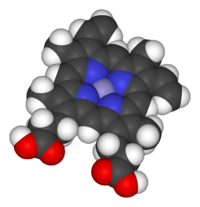
Back بروتين الهيم Arabic Hemeprotein BS Hämoproteine German Hemoproteína Spanish همپروتئین Persian Hémoprotéine French Hemoproteína Galician Hemoprotein Croatian Emoproteina Italian 헴단백질 Korean

A hemeprotein (or haemprotein; also hemoprotein or haemoprotein), or heme protein, is a protein that contains a heme prosthetic group.[1] They are a very large class of metalloproteins. The heme group confers functionality, which can include oxygen carrying, oxygen reduction, electron transfer, and other processes. Heme is bound to the protein either covalently or noncovalently or both.[2]
The heme consists of iron cation bound at the center of the conjugate base of the porphyrin, as well as other ligands attached to the "axial sites" of the iron. The porphyrin ring is a planar dianionic, tetradentate ligand. The iron is typically Fe2+ or Fe3+. One or two ligands are attached at the axial sites. The porphyrin ring has 4 nitrogen atoms that bind to the iron, leaving two other coordination positions of the iron available for bonding to the histidine of the protein and a divalent atom.[2]
Hemeproteins probably evolved to incorporate the iron atom contained within the protoporphyrin IX ring of heme into proteins. As it makes hemeproteins responsive to molecules that can bind divalent iron, this strategy has been maintained throughout evolution as it plays crucial physiological functions. The serum iron pool maintains iron in soluble form, making it more accessible for cells.[3] Oxygen (O2), nitric oxide (NO), carbon monoxide (CO) and hydrogen sulfide (H2S) bind to the iron atom in heme proteins. Once bound to the prosthetic heme groups, these molecules can modulate the activity/function of those hemeproteins, affording signal transduction. Therefore, when produced in biologic systems (cells), these gaseous molecules are referred to as gasotransmitters.

Because of their diverse biological functions and widespread abundance, hemeproteins are among the most studied biomolecules.[4] Data on heme protein structure and function has been aggregated into The Heme Protein Database (HPD), a secondary database to the Protein Data Bank.[5]
- ^ "Heme Prosthetic Group Definition". earth.callutheran.edu. Retrieved 2023-04-27.
- ^ a b Nelson DL, Cox MN (2000). Lehninger, Principles of Biochemistry (3rd ed.). New Yorkm: Worth Publishing. ISBN 1-57259-153-6.
- ^ Frazer, David M.; Anderson, Gregory J. (March 2014). "The regulation of iron transport: The Regulation of Iron Transport". BioFactors. 40 (2): 206–214. doi:10.1002/biof.1148. PMID 24132807. S2CID 2998785.
- ^ Reedy CJ, Elvekrog MM, Gibney BR (January 2008). "Development of a heme protein structure-electrochemical function database". Nucleic Acids Research. 36 (Database issue): D307–D313. doi:10.1093/nar/gkm814. PMC 2238922. PMID 17933771.
- ^ Gibney BR. "Heme Protein Database". Brooklyn, NY: Brooklyn College.